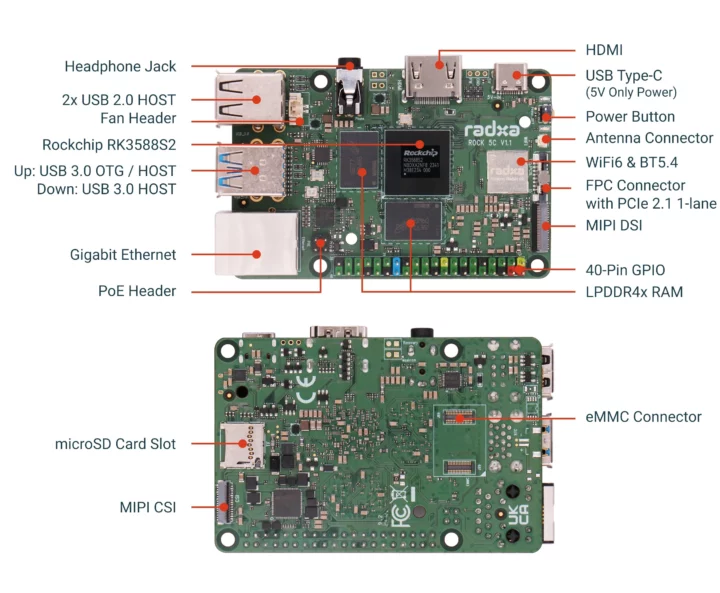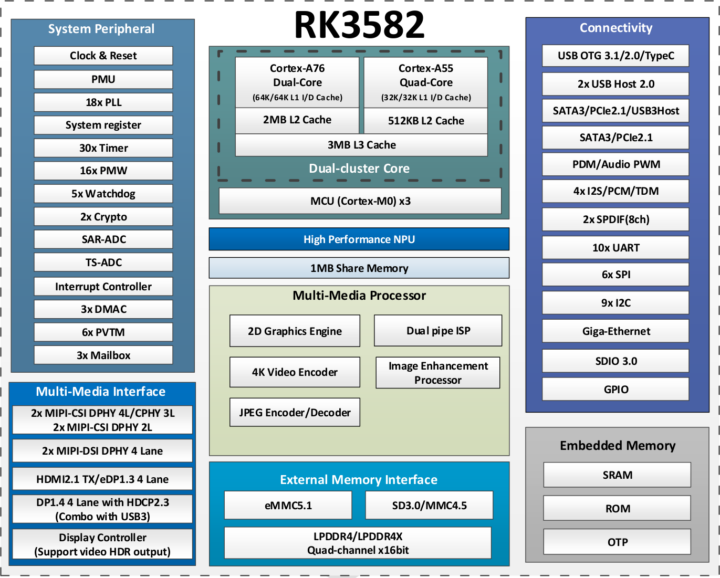Rockchip RK3582 hexa-core SoC is pin-to-pin compatible with the popular Rockchip RK3588S octa-core Cortex-A76/A55 SoC, but only features two Cortex-A76 cores, a 5 TOPS NPU (instead of 6 TOPS) and does not come with a 3D GPU.
I was first made aware of the Rockchip RK3582 in October 2023 when I was sent a photo of a board allegedly for a TV box, but while the RK3582 still features a 4K video decoder, the lack of a 3D GPU could make it problematic with 3D accelerated user interface. We now have more details with Radxa having released the datasheet and a few more interesting details.
Rockchip RK3582 specifications:
- Hexa-core CPU – 2x Cortex-A76 and 4x Cortex-A55 cores in dynamIQ configuration (frequencies are still shown as TBD in the datasheet)
- GPU
- No 3D GPU
- 2D graphics engine up to 8192×8192 source, 4096×4096 destination
- AI Accelerator – 5 TOPS NPU 3.0 (Neural Processing Unit)
- VPU
- Video decoding
- 8Kp60 H.265, VP9, AVS2, 8Kp30 H.264 AVC/MVC
- 4Kp60 AV1
- 1080p60 MPEG-2/-1, VC-1, VP8
- Real-time 4Kp60 encoding with H.265/H.264; multi-channel encoding supported at lower resolutions
- Video decoding
- Memory I/F – LPDDR4/LPDDR4x/LPDDR5 up to 32GB
- Storage – eMMC 5.1, SD/MMC, SATA 3.0 (multiplexed with PCIe 2.0), FSPI (Flexible SPI)
- Video Output
- Dual HDMI 2.1 / eDP 1.3 up to 8Kp60 (4Kp60 for eDP)
- 1x DisplayPort 1.4a up to 8Kp30 (multiplexed with USB 3.0)
- Dual MIPI DSI output up to 4Kp60
- Bt.1120 video output up to 1080p60
- Up to four independent displays (up to 1x 8Kp60, 2x 4Kp60, 1x 2048×1080 @ 60 Hz)
- Video Input/Camera
- 48MP (2x 24MP) ISP with HDR and 3D NR support; multi-camera input
- 2x MIPI DC (4-lane DPHY v2.0 or 3-lane CPHY V1.1)
- 4x 2-lane MIPI CSI
- DVP camera interface
- Audio
- 2x 8-channel I2S, 2x 2-channel I2S
- 2x SPDIF
- 2x 8-channel PDM (for mic arrays)
- 2-channel digital audio codec (16-bit DAC)
- VAD engine
- Networking – Dual Gigabit Ethernet
- USB – 1x USB 3.1 Gen 1 up to 5 Gbps (multiplexed with DisplayPort), 1x USB 3.1 Gen 1 (multiplexed with Combo “PIPE PHY2”), 2x USB 2.0 host
- 2x Combo PIPE PHY interfaces
- Combo PIPE PHY0/1 – SATA III or PCIe2.1 up to 5 Gbps
- Combo PIPE PHY2 – SATA III, PCIe 2.1, or USB 3.0
- Other I/O – 6x SPI, 9x I2C, 10x UART, GPIOs, 12-bit ADC (SARADC), SDIO 3.0, 3x CAN Bus
- Package – FCCSP1253L; 17 x 17mm
- Manufacturing process – 8nm LP
The real changes over RK3588S are the two Cortex-A76 cores, the lack of Arm Mali-G610 GPU, and the NPU being limited to 5 TOPS. Some smaller changes in the datasheet are the encoder capabilities (4Kp60 vs 8Kp30, but that is probably just a different way of saying the same thing) and the resolution for the fourth display can be up to 2048 x 1080.

We learned about the new Rockchip RK3582 as Radxa unveiled the upcoming ROCK 5C SBC powered by a Rockchip RK3588S2 (unclear how it differs from RK3588S) and the ROCK 5C Lite based on the pin-compatible RK3582. We’ll cover those two boards in more detail once they become available. But the announcement thread has some intriguing tidbits:
If you are lucky, you can unlock the RK3582 to Quad A76!
..
GPU is unknown, if you are lucky, you will have GPU, if not, then no GPU.
The way I read this is that the RK3582 is an RK3588S with defects. Rockchip must have noticed they had a non-negligible number of RK3588S that did not pass QC (quality control) due to a few Cortex-A76 cores not working, the GPU failing, or the NPU not working up to expectations, so the RK3582 was born. That’s why you may get four Cortex-A76 cores or the GPU working in some RK3582 parts, but likely not both of them, unless the chip was downgraded from being a RK3588S due to the NPU.
Thanks to Geoffrey for the tip.

Jean-Luc started CNX Software in 2010 as a part-time endeavor, before quitting his job as a software engineering manager, and starting to write daily news, and reviews full time later in 2011.
Support CNX Software! Donate via cryptocurrencies, become a Patron on Patreon, or purchase goods on Amazon or Aliexpress





selling lottery tickets – way to go Radxa !
Based on the prices currently floated by Radxa, the boards based on RK3582 are $15 cheaper and the other features are the same. So that’s a big discount, so if people are sure they won’t use the GPU, two Cortex-A76 cores are fine, and they don’t intend on using the NPU to the max, the RK3582 will work just as well as the RK3588S.
There’s still a question mark about video decoding because although it’s in the RK3582 datasheet, I can see Radxa saying it’s not clear what the actual status is. I’m sure this question will be answered by launch.
“No GPU” in the headline is misleading, got me to stumble in here instantly though.
It certainly looks like enough for a TV box. Have any of those boxes or the OSes running on them legitimately leveraged an NPU for upscaling or something?
I think Android needs a 3D graphics accelerator with OpenGL ES / Vulkan API to work properly. Even Kodi can make use of this to render the interface more smoothly. The RK3582 only comes with a 2D graphics accelerator.
It will end up as the same garbage as RK3399 was: impossibility to decide how to spread the workload between two big cores or four small ones that together are as fast. I.e. you’ll be forced to send half of your workload to slow cores and regret it once they complete too late. The could instead have kept 4 big cores and dropped the 4 small ones wih the same total performance but without inflicting long tails on processing time. Sadly, small cores have long become a marketing help to pretend having many cores, a few of which are really usable. In practice you should never run a CPU-bound task on such cores, and you have no other choice because there are way more cores than you can keep busy with the compatible workloads :-/
This architecture came from phones. The small cores are meant to run email or chat and save your battery. Then when you run a game the big cores turn on with high performance but they kill your battery.
I know but it’s still pure marketing crap. It abuses the fact that consumers do not understand anything to scheduling and believe hard that each separate program requires its own processor. It’s way more efficient to have less cores round-robin a number of low-bandwidth tasks than to let many cores run them at low speed and stay up. IMHO the only way to use little cores would be to have a single one, precisely for these low-performance tasks. But that doesn’t sell well, so marketing requires many more.
> The could instead have kept 4 big cores
No, because RK3582 is the result of QA selection. RK3588S2 dies not fully passing QA end up being sold as RK3582 lacking NPU performance and/or one of the two A76 clusters and/or GPU.
In this case it can make sense if it’s way cheaper. But it’s not impossible that it will have DVFS difficulties and/or higher than expected current draw, as many chips that fail QA and are repurposed due to bad etching precision.
Here you can see some of the ‘rules’ that simply hide DT contents like core6/core7 by default even if those core are functional (and you can also spot another 3588 variant called RK3583 there).
So if your RK3582 has four functional A76 a simple DT overlay might bring them back. As for performance / DVFS we’ll see soon what the boot BLOBs will do.
Hehe not surprised, they probably don’t even try to laser-disconnect them, and might just use JTAG at the end of the testing phase to program a fuse indicating which ones are good or bad and let software deal with it.
A Cortex-A72 core is 3x the size (area) of an A53 core but has only twice the performance. So 2xA72+4xA53 is about 20% smaller than 4xA72 and has about the same performance in total.
yes but workloads that can exploit 4 A53 are basically inexistent. I claim that they could have served exactly the same use cases with 2xA72 and 1xA53 using smaller area, or 3xA72+1xA53 with the same power and area and more effective processing power.
> 4Kp60 vs 8Kp30, but that is probably just a different way of saying the same thing
It’s not. 8K UHD (7680×4320) is 4x the pixel count of 4K UHD (3840x2160), so 8Kp30 requires double the throughput of 4Kp60 as well as larger reference images.
I bouhgt radxa 5c lite. Iam lucky man. I have GPU. It is not clear if all 4MP but works…